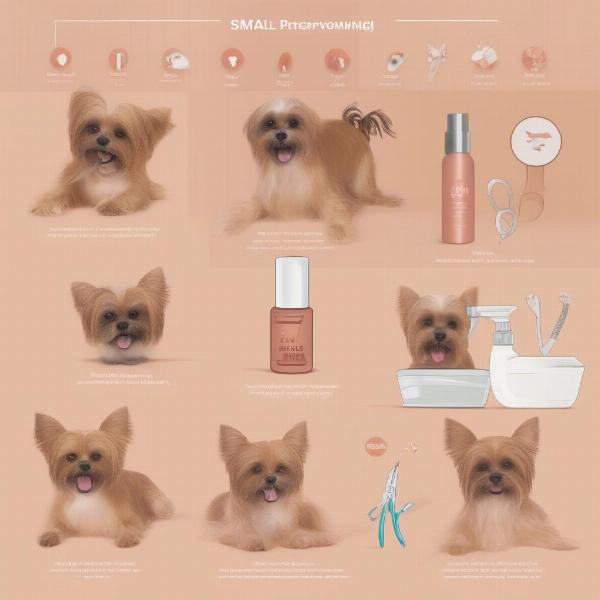Napkin dogs, though not a recognized breed, often refers to small, toy breeds that are easily carried around, sometimes even tucked into a napkin. This guide delves into the considerations for owning such a small dog, covering everything from choosing the right breed to ensuring their health and well-being. We’ll explore the joys and challenges of napkin dog ownership, providing practical advice for both seasoned and aspiring pet parents.
Choosing the Right “Napkin Dog” Breed
While “napkin dog” isn’t a breed itself, it conjures up images of tiny, portable pups. Popular choices include Chihuahuas, Yorkshire Terriers, Pomeranians, and Maltese. Researching breed characteristics is crucial. Are you looking for a cuddly companion, an energetic playmate, or a quiet lap dog? Each breed has its own temperament and needs. Consider factors like grooming requirements, exercise levels, and potential health issues. Matching these to your lifestyle ensures a happy and harmonious relationship.
Health and Care for Your Small Companion
Small dogs, due to their size, can be prone to certain health conditions like hypoglycemia and tracheal collapse. Regular veterinary checkups are vital. Dental care is also crucial, as small breeds are often predisposed to dental problems. Provide a balanced diet, appropriate exercise, and a stimulating environment to maintain their physical and mental health.
Training and Socialization: Essential for Small Dogs
Don’t let their size fool you, “napkin dogs” need training and socialization just like larger breeds. Early socialization helps them develop into well-adjusted adults, comfortable around people, other animals, and various environments. Positive reinforcement training methods work best. Consistency and patience are key to establishing good behavior and preventing undesirable habits.
Nutrition and Feeding: Small Dog, Big Needs
“Napkin dogs” have specific dietary requirements due to their fast metabolism and small stomachs. Choose high-quality dog food formulated for small breeds, ensuring it provides the necessary nutrients for their size and activity level. Avoid overfeeding, which can lead to obesity and other health issues. Consult your veterinarian for guidance on appropriate portion sizes and feeding schedules.
Grooming Your Tiny Companion
Regular grooming keeps your “napkin dog” looking and feeling their best. Depending on the breed, this may include brushing, bathing, nail trimming, and ear cleaning. Establish a grooming routine early on to make it a positive experience. Professional grooming can be beneficial for breeds with long or complex coats.
 Grooming a Napkin Dog
Grooming a Napkin Dog
Exercise and Enrichment: Keeping Your Small Dog Active
Even “napkin dogs” require regular exercise and mental stimulation. Daily walks, playtime, and interactive toys help keep them physically and mentally engaged. Provide a stimulating environment with puzzles and toys to prevent boredom and destructive behaviors. Remember to tailor the intensity and duration of exercise to your dog’s age and breed.
Conclusion
Owning a “napkin dog” can be a rewarding experience, bringing companionship and joy. However, it’s crucial to understand their specific needs and commit to providing proper care. By choosing the right breed, prioritizing health and well-being, and investing in training and socialization, you can ensure a happy and fulfilling life for your small companion.
FAQ
-
Are “napkin dogs” suitable for apartment living? Yes, their small size often makes them well-suited for apartment life, but they still need adequate exercise and mental stimulation.
-
Do “napkin dogs” require a lot of grooming? Grooming needs vary by breed. Short-coated breeds require minimal grooming, while long-coated breeds need more frequent brushing.
-
Are “napkin dogs” good with children? This depends on the individual dog’s temperament and the child’s age and behavior. Early socialization and proper supervision are crucial.
-
What health problems are common in “napkin dogs”? Some small breeds are prone to hypoglycemia, tracheal collapse, and dental issues. Regular veterinary checkups are essential.
-
Are “napkin dogs” easy to train? Like all dogs, “napkin dogs” benefit from early training and socialization. Positive reinforcement methods work best.
Related Articles
- dog friendly holiday parks in devon
- caravans in devon dog friendly
- woolacombe dog friendly accommodation
- holiday parks cornwall dog friendly
About ILM Dog
ILM Dog is your comprehensive resource for expert advice on dog breeds, health, training, nutrition, and much more. We offer practical guidance and insights to help you provide the best possible care for your canine companion. From choosing the right breed to ensuring their lifelong well-being, we are committed to helping you navigate the joys and challenges of dog ownership. Contact us today for personalized support and information. Email: [email protected], Phone: +44 20-3965-8624.